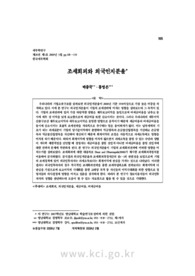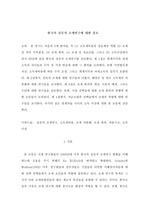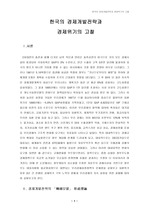

PARTNER
검증된 파트너 제휴사 자료
지속적인 세무전략이 투자효율성에 미치는 영향 (The Effect of Sustainable Tax Strategies on Investment Efficiency)
71 페이지
최초등록일 2025.06.21
최종저작일
2020.11

-
미리보기
서지정보
· 발행기관 : 한국세무사회 부설 한국조세연구소
· 수록지 정보 : 세무와 회계연구 / 9권 / 4호 / 319 ~ 389페이지
· 저자명 : 박종일
초록
본 연구는 지속적인 세무전략의 기업일수록 투자효율성이 증가하는지를 실증적으로 규명하는 데 있다. 이전 연구에서는 높은 품질의 재무보고가 투자효율성을 증가시킨다는 증거를 제시하였다(Biddle et al. 2009). 또한 이전 연구들은 현금유효세율에 대한 변동성을 낮추는 지속적인 세무전략의 기업은 이익의 지속성이 높고(McGuire et al. 2013), 더 투명한 정보환경에 있어 기업투명성이 높으며(Neuman et al. 2013), 기업신용등급이 더 높다는 결과를 보고하였다(신상이․박종일 2019). 따라서 본 연구는 선행연구의 범위를 확장시켜 지속적인 세무전략의 기업일수록 투자효율성이 증가하는지를 알아보고자 한다.
이를 알아보기 위해 본 연구는 관심변수인 지속적인 세무전략을 McGuire et al.(2013)의 방법인 과거 5년간으로 측정되는 Cash ETR 또는 GAAP ETR의 변이계수를 이용하고, 종속변수는 Biddle et al.(2009)의 방법에 따라 비정상 투자수준에 대한 개별기업의 잔차를 추정한 후, 절댓값을 취하여 분석에 이용하였다. 또한 본 연구는 총투자를 설비투자(또는 자본적 지출)와 연구개발비 투자로 나누어 살펴보았다. 분석기간은 2004년부터 2017년까지이고, 유가증권과 코스닥기업을 대상으로 최종표본 9,148개 기업/연 자료가 이용되었다.
실증분석 결과는 일정 통제변수를 고려한 후에도 지속적인 세무전략과 투자효율성 간에 양(+)의 관계로 나타났다. 특히 앞서의 결과는 주로 설비투자보다는 연구개발비 투자에 기인한 것으로 나타났다. 또한 앞서의 관계는 변이계수의 측정방법(예로, Cash ETR, GAAP ETR)에 상관없이 일치된 결과로 나타났고, 전체표본을 KOSPI와 KOSDAQ 표본으로 나누어 분석해도 모두 일관된 증거를 보였다. 이와 달리, 법인세를 최소화하는 조세회피 전략은 투자효율성과 음(-)의 관계로 나타났고, 주로 설비투자보다는 연구개발비에서 나타났다.
이상을 요약하면, 본 연구는 유효세율에 대한 변동성을 낮추는 지속적인 세무전략의 기업은 연구개발비의 투자효율성이 증가하는 반면에, 법인세를 최소화하는 조세회피 전략의 기업은 연구개발비의 투자비효율성이 증가한다는 결과를 비교해 보여 주었다는 데 의의가 있다. 또한 본 연구는 선행연구와 달리 세무 측면의 지속적인 세무전략과 투자효율성 간의 관계를 처음으로 탐구한 연구라는 점에서도 의미가 있다. 특히 본 연구의 발견에서는 지속적인 세무전략이 투자효율성과 양(+)의 관계로 나타나 지속적인 세무전략 정보는 높은 재무보고의 질을 나타내는 신뢰할 만한 지표임을 시사해 주고 있다.영어초록
This study examines how sustainable tax strategies relates to firm-level investment efficiency. “Sustainable tax strategies” is the dimension of a firm’s tax strategy that focuses on maintaining consistent tax outcomes over time (McGuire et al. 2013). Prior research indicates that firms with sustainable tax strategies experience more persistent, hence more predictable, earnings (McGuire et al. 2013). Neuman et al. (2013) provide preliminary evidence that firms with sustainable tax strategies have more transparent information environments as well as corporate transparency. Shin and Park (2019) shows that firms with sustainable tax strategies is positively associated with firms’ credit rating. In addition, prior studies suggest that higher-quality financial reporting should increase investment efficiency (e.g., Biddle and Hilary 2006;Biddle et al. 2009). Therefore, I link and extend this line of two research, this study investigates whether firms with sustainable tax strategies improves investment efficiency. For comparison, I also investigate whether the firms with minimization tax strategies is associated with investment efficiency.
For analysis, I construct a measure of sustainable tax strategy (hereafter STS) using the coefficient of variation for cash (GAAP) ETRs over a five-year period (i.e., t to t-4) following McGuire et al. (2013). Firms with low variability report a narrow range of cash (GAAP) ETRs over time, which suggests they emphasize a sustainable tax strategy. To measure minimization tax strategies (i.e., tax avoidance), I use long-term the cash (GAAP) ETR measured as the five-year period following Dyreng et al. (2008). The dependent variable of this study is investment efficiency. I measure this variable following Biddle et al. (2009). This is, the primary dependent variable in my analysis is the absolute value of the abnormal investment (hereafter INV, CAPEX and R&D), so a higher value will indicate a higher investment inefficiency. I construct a sample of firm-year observations from 2004~2017 with data in both KOSPI and KOSDAQ listed firms, final sample is 9,148 firm-year observations.
Empirical results reveal the following. First, the dependent variable is total investment, I find that the negative and significant coefficients on STS at the 1% level in all specifications of the model. This results lend support to hypothesis that firms with sustainability tax strategies is positively associated with firms’ investment efficiency. Second, as a additional test, I further examine the effects of firms with sustainable tax strategies on each of capital investment (CAPEX) and research and development investment (R&D), and evaluate whether this paper conclusions are driven by either or both types of investment. when the dependent variable is R&D investment, I find that firms with sustainable tax strategies is positively associated with investment efficiency at the 1% level. However, I do not find a significant association between firms with sustainable tax strategies and investment efficiency. In other words, the results for R&D is consistent with what I find for the total investment. Therefore, earlier my results is driven by R&D investment efficiency. These results are robust to alternative measures of cash ETR and GAAP ETR. Furthermore, my results is robust when I divided the sample into KOSPI and KOSDAQ firms are quantitatively similar. Meanwhile, when the dependent variable is R&D investment, I find that firms with minimization tax strategies is positively associated with investment inefficiency at the 1% level.
In summary, my results show that the sustainability of a firm’s tax strategy over time increases a firm’s R&D investment efficiency, whereas firms with minimization tax strategies increases a firm’s R&D investment inefficiency. Therefore, my results suggest that the sustainability of firms’ tax strategies are associated with lower over- or under-investment. My findings provide more direct evidence on the positive relation between sustainable tax strategies and investment efficiency. Specially, my results suggest that sustainable tax strategies indicates higher overall financial reporting quality. Further, this is the first research to address the association between investment efficiency and sustainable tax strategies. Therefore, my results can provide novel and additional evidence to the related research (i.e., sustainable tax strategies, investment efficiency, and financial reporting quality).참고자료
· 없음태그
-
자주묻는질문의 답변을 확인해 주세요

꼭 알아주세요
-
자료의 정보 및 내용의 진실성에 대하여 해피캠퍼스는 보증하지 않으며, 해당 정보 및 게시물 저작권과 기타 법적 책임은 자료 등록자에게 있습니다.
자료 및 게시물 내용의 불법적 이용, 무단 전재∙배포는 금지되어 있습니다.
저작권침해, 명예훼손 등 분쟁 요소 발견 시 고객센터의 저작권침해 신고센터를 이용해 주시기 바랍니다. -
해피캠퍼스는 구매자와 판매자 모두가 만족하는 서비스가 되도록 노력하고 있으며, 아래의 4가지 자료환불 조건을 꼭 확인해주시기 바랍니다.
파일오류 중복자료 저작권 없음 설명과 실제 내용 불일치 파일의 다운로드가 제대로 되지 않거나 파일형식에 맞는 프로그램으로 정상 작동하지 않는 경우 다른 자료와 70% 이상 내용이 일치하는 경우 (중복임을 확인할 수 있는 근거 필요함) 인터넷의 다른 사이트, 연구기관, 학교, 서적 등의 자료를 도용한 경우 자료의 설명과 실제 자료의 내용이 일치하지 않는 경우
“세무와 회계연구”의 다른 논문도 확인해 보세요!
-
가상자산에 대한 정부 세법 개정안의 평가 및 개선방안 52 페이지
정부의 금년 세법 개정안은 비트코인 등 가상자산 거래로부터 발생한 소득에 대해 2021년 10월부터 소득세를 부과하는 것을 목표로 가상자산에 대한 소득세 과세방안을 포함하고 있다. 즉, 우리나라의 소득세법이 열거주의를 채택하고 있음에 따라 그동안 소득세를 과세하지 않았던 가상자산 거래이익에 대해 소득세법에 기타소득의 한 종류로 열거하여 규정하되, 누진세율이.. -
종합부동산세와 재산세의 이중과세조정제도 49 페이지
현행 부동산 보유세는 지방세인 재산세와 국세인 종합부동산세로 이원화되어 있다. 2005년 보유세 개편으로 건축물과 토지가 모두 재산세 부과대상으로 변경되고, 고액의 부동산을 보유한 일부 계층을 대상으로 재산세 이외에 새로운 보유세를 추가적으로 부과하기 위하여 종합부동산세법을 제정하였다. 종합부동산세의 도입으로 동일한 부동산 보유에 대해 재산세와 종합부동산세.. -
지방세 세무대리 업무 인식에 관한 연구 40 페이지
본 연구는 지방세 세무대리 업무 인식에 대하여 설문조사를 실시해 분석하였다. 구체적으로, 추가적인 지방세 세무대리인 제도 도입의 적절성을 파악하기 위해 현재 제도의 납세자 보호 측면, 문제점, 개선사항, 지방세 행정사 제도의 도입(안) 등 다양한 측면에 대한 설문을 시행하였다. 설문조사는 오프라인 설문과 동시에 응답률을 높이기 위해 온라인 설문을 실시하였다.. -
기본소득 재원으로서 데이터세 도입방안 58 페이지
현대 사회는 4차 산업혁명이라고 일컬어지는 디지털화에 따라 세계 경제도 디지털화되어 가고 있다. 전통적으로 경제가 성장하면 양질의 일자리가 생겨나지만, 현대 사회는 기술의 발전으로 자동화가 확산되면서 장차 인공지능이나 로봇이 인력을 대체하는 사회가 올 것이라고 우려하고 있다. 특히 최근 세계적으로 불어닥친 코로나 바이러스 감염증의 확산으로 비대면으로 업무를..
찾으시던 자료가 아닌가요?
지금 보는 자료와 연관되어 있어요!
문서 초안을 생성해주는 EasyAI




